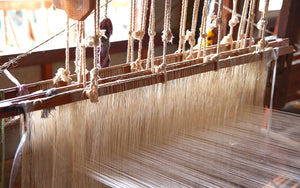How is a fouta made ?
From the design of the models to the customization, here are the different steps to make a fouta, the trendy beach towel!
The development of the models
According to the seasons, the trends and the new uses, new models are regularly created. Colors, patterns, weaving... foutas are constantly revisited to be up to date. Surfing on the latest trends, By Foutas never stops reinventing itself by offering you a wide range of foutas. Every year we create 1 or 2 new models that we add to the more classic designs. As a traditional beach towel, as a sarong or as an XXL beach towel to share with several people during a picnic, there is something for everyone. And don't forget that a fouta can also be used indoors: bath towel, bed throw, sofa throw, yoga towel...
The choice of fabric
If most foutas are made of cotton, the traditional material, there are some models in linen. Did you know that? At By Foutas, we practice upcycling because we make foutas with 100% recycled cotton thread. We work with a yarn supplier who recovers the manufacturing surplus of several international ready-to-wear brands. After a recycling process without chemical additives, the yarn obtained is ready to be woven again with an impeccable quality.
The different types of weaving
To realize our foutas we have several types of weavings at our disposal. There is first of all the traditional flat weave which is essential in the world of the fouta. Then, the fouta honeycomb which offers a honeycomb aspect and a very pleasant touch. The weaving herringbone and diamond (also called rhombus), more complex to achieve, give a great elegance to foutas. Finally, the Jacquard weaving allows to realize more complex patterns on the foutas.
A handcrafted weaving from edge to edge
Made mainly from cotton threads, the fouta is woven with the help of looms equipped with several weaving programs. These machines, often capricious, require the supervision and the regular intervention of weavers who learned to tame them with time. If the industrial foutas do not have the woven edges (curling with drying), the artisanal foutas, them, are woven of edge to edge what offers an aspect much more aesthetic and increases the durability of fouta.
Cutting and finishing
Then comes the stage of the cutting. Every 2 meters, standard size of a fouta, is woven a white band on about twenty centimeters which is used as limit between two foutas and of mark for the cut. Once the cuts are made, it is time for the finishing touches. We check that the fabric is not frayed in some places and we cut if necessary the small threads which exceed for an impeccable finish. The process is the same for the XXL foutas but this time it is 3 meters long fabrics that are cut.
The realization of the fringes
To realize the fringes at both ends of the fouta, no need for machines; this step is done by hand. The craftswomen rub between their hands the white threads of the ends so as to create several small braids which they will come to tie at the end of the fouta in order to bring this recognizable aesthetic touch among so many others.
Customization
Finally comes the moment for the fouta manufacturer to affix its signature, its trademark, in the form of a sewn or embroidered logo for example. At By Foutas, you can also personalize your fouta by choosing a font and a message to embroider. Want to personalize your fouta ?


